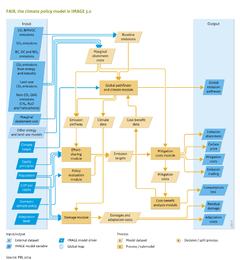Climate policy/Description: Difference between revisions
Jump to navigation
Jump to search
Oostenrijr (talk | contribs) m (Text replace - "CO<sub>2</sub>" to "CO<sub>2</sub> ") |
Oostenrijr (talk | contribs) No edit summary |
||
| Line 1: | Line 1: | ||
{{ComponentDescriptionTemplate | {{ComponentDescriptionTemplate | ||
|Reference=Den Elzen et al., 2007; Van Vuuren et al., 2011a; Meinshausen et al., 2011b; Den Elzen et al., 2013; Hof et al., 2013; Roelfsema et al., 2014; Den Elzen et al., 2012a; Hof et al., 2012; Hof et al., 2008; Hof et al., 2010; De Bruin et al., 2009; | |Reference=Den Elzen et al., 2007; Van Vuuren et al., 2011a; Meinshausen et al., 2011b; Den Elzen et al., 2013; Hof et al., 2013; Roelfsema et al., 2014; Den Elzen et al., 2012a; Hof et al., 2012; Hof et al., 2008; Hof et al., 2010; De Bruin et al., 2009; | ||
|Description=FAIR consists of six linked modules as presented in the flowchart and described briefly below. | |Description=FAIR consists of six linked modules as presented in the flowchart and described briefly below. | ||
| Line 19: | Line 19: | ||
===Estimation of consumption losses=== | ===Estimation of consumption losses=== | ||
Consumption losses due to mitigation, adaptation and climate change damage are estimated based on a simple Cobb-Douglas economic growth model. Each region is calibrated separately to the exogenous GDP path. Damages, adaptation and abatement costs are subtracted from investment or consumption to determine either the direct replacement effect on consumption, or the indirect effect from replacing investments. | Consumption losses due to mitigation, adaptation and climate change damage are estimated based on a simple [[Cobb-Douglas economic growth model|Cobb-Douglas economic growth model]]. Each region is calibrated separately to the exogenous GDP path. Damages, adaptation and abatement costs are subtracted from investment or consumption to determine either the direct replacement effect on consumption, or the indirect effect from replacing investments. | ||
}} | }} | ||
Revision as of 12:01, 1 July 2014
Parts of Climate policy/Description
| Component is implemented in: |
|
| Related IMAGE components |
| Models/Databases |
| Key publications |
| References |
|
